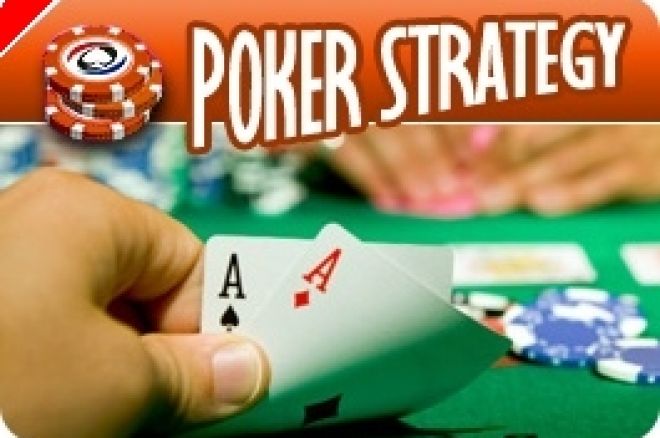Stud Poker Strategy: Pot-Limit Stud

I just returned from a great trip to Paris, France, visiting my daughter and that great city. I also went to play poker. I played in two clubs �C each in the nicest part of the city, right near the Arc D'Triomphe. What a beautiful scene. I promise a poker room review of each place in some subsequent columns.
While I was there I was fortunate enough to get seated in a �250 buy-in, pot-limit dealer's choice game. They play it with two �5 blinds. The dealer gets to choose from among about a dozen games including all versions of stud.
I hadn't played pot-limit stud in a public poker room since I had played at the Victoria Casino in downtown London seven years earlier. Still, I relished the chance to play, having played many times in home games. I've always thought of stud as my best game and looked forward to the opportunity to play it for relatively high stakes.
I was not disappointed.
Some interesting hands came up that demonstrated the difference between pot-limit and limit strategies in stud. I'll share them with you here.
I was playing with about �250 in front of me. (A Euro is worth about $1.50.)
They played stud just as if it were a flop game, with two blinds to the left of the dealer and no antes. There was no low-card forced bet. Other than that it was played the same as a limit stud game, except, obviously, for the betting limit.
It was my deal. I dealt myself a wired pair of nines and a four. There was one nine and one four out. The blinds posted �5 each. The next player called, then a player folded, then another call from a player with a jack. A player with an ace raised the pot to �30. One player called, with a queen; the next two folded and it was up to me.
In a standard limit game this would be an automatic fold for me. I'd reason that I was probably up against two players with overpairs to my hidden nines. I'd see that one of the nines I needed for trips was dead; I'd see that one of the three fours I needed for two pair or a full house was also dead. And I'd conclude that the extremely long odds I'd be getting to hit my hand didn't warrant entering the competition for the pot. Even if I hit a miracle nine on the next card, I'd be likely to have two or three players drawing against me when I raised the bet from the ace �C since the pot would be large, my bet would still be small, and they'd be getting good odds for a call. I'd have to face the possibility of higher trips, a straight or a flush draw. Unless I filled up, which was an extremely unlikely outcome given the two dead cards, I really wouldn't be certain of winning even with trip nines. Long-shot draw, insufficient pot odds, and the possibility of being drawn out on equals fold.
But this was another story. This was pot-limit. For �25 I had a shot at a hand that might win me double or triple my stack: 40-to-1 or so against me getting the miracle nine, and the added possibility of getting a runner-runner full house, and the potential for �750 or more if I hit and got the maximum from the hand. Now the equation was more balanced. A call could be justified (albeit thinly).
As it turned out, I bombed on fourth street and folded to a bet. The winner ended up with queens up, the pair of aces failing to improve.
Another example of the difference between pot-limit and limit stud came up in the next orbit when I again called stud.
A player in front of me raised the blinds to �35 with a king. A player after him, with a queen, called him, and action was to me �C with the two blinds and a third player with an ace in for �5 behind me but yet to act on the raise. I had three suited cards headed by the nine. One of my suit was out. I had about �200 in my stack and everyone else had me out-stacked.
Normally, in a limit game, I'd call that raise. I'd see the size of the pot and surmise the eventual size of the pot given the players who were in and who were likely to be in on third street. I'd see that I was getting an excellent price for my call.
But this was a pot-limit game. I would not be likely to face a small bet on fourth street, when I'd only have a four-flush even if I were lucky enough to get another suited card. Did I really want to play what was only a drawing hand for what would probably be all my chips?
Still, I was going to get great pot odds with a call, assuming that the other players called the additional �30. �35 to call for a pot that would probably have �115 or more in it. And my implied odds were tremendous. I could triple up.
Against my better judgment I called. Something unanticipated convinced me that it was a bad move. I failed to think about the possibility that someone would raise. But that's what happened. The small blind called with a seven. The big blind folded. And then the ace, who had only called the big blind earlier, raised the �30 raise by �150. The king called. The queen folded. And I was faced with the uncomfortable option of calling for �150 �C essentially putting me all in �C against two players presumably each with a premium pair, while I had only a three-flush.
In a limit game this type of situation can never occur. Sure, the ace might have raised, but it would have only been by a multiple of a single small bet on third street. In pot limit, if there is the possibility of a raise there is the possibility of a huge raise, as in this case.
I folded, of course, and saw a showdown of aces up versus trips �C and a huge pot. Maybe I would have drawn the flush. Who knows. It wasn't worth the price to find out.
Pot limit stud can be a scary game. On any betting round you may have to put in all of your chips. And in stud, unlike hold'em, there are five betting rounds for the pot to grow each increasing the chances that either you or your opponent will eventually commit everything by betting's end.
The bluffing possibilities are greatly enhanced as well. Consider the following hand:
You and the others at the table have stacks of �1,000 or more. You have split aces pre-flop. You raise the pot and get two callers for �20 each. The pot's at �70 on fourth street.
You are high on fourth street with your aces �C and with nothing else yet. You lead out with a pot-sized bet of �70. One player folds and the other player, who had a queen and just got a ten, raises you to �280. What do you do?
Is he capable of a bluff? Does he figure that you might be pushing a wired pair or bluffing yourself? Does he tend to be wild or conservative? Did he hit two pair? If he hit the trips then why is he trying so hard to knock you out? If he has two pair does it make sense for you to call along? In limit play, calling in a situation like this is almost automatic because the size of the bet is so small when compared with the current and expected pot size. But in pot-limit, you really have to know the player to come up with a good answer, since the bet is so large.
(This actually happened to me in a game. I ended up deciding to re-raise for the rest of my chips. He folded, after thinking a long time.)
I'd like to say that I won a ton of money at this dealer's choice game in Paris. Unfortunately, I lost over �300 �C almost all of it on an Omaha hand that I shan't go into here (but if you're curious feel free to e-mail me at [email protected]).
Pot-limit stud is a great game, requires excellent hand- and player-reading skills, and some serious stones. I'd play it regularly if any casinos would deal it over here. Who knows? Maybe everyone will come to their senses and start spreading this great game.








